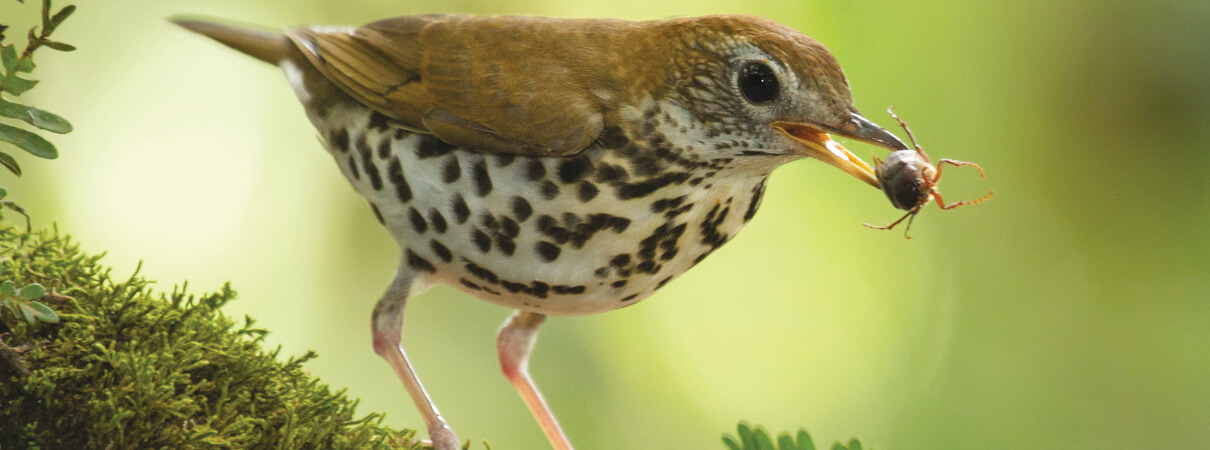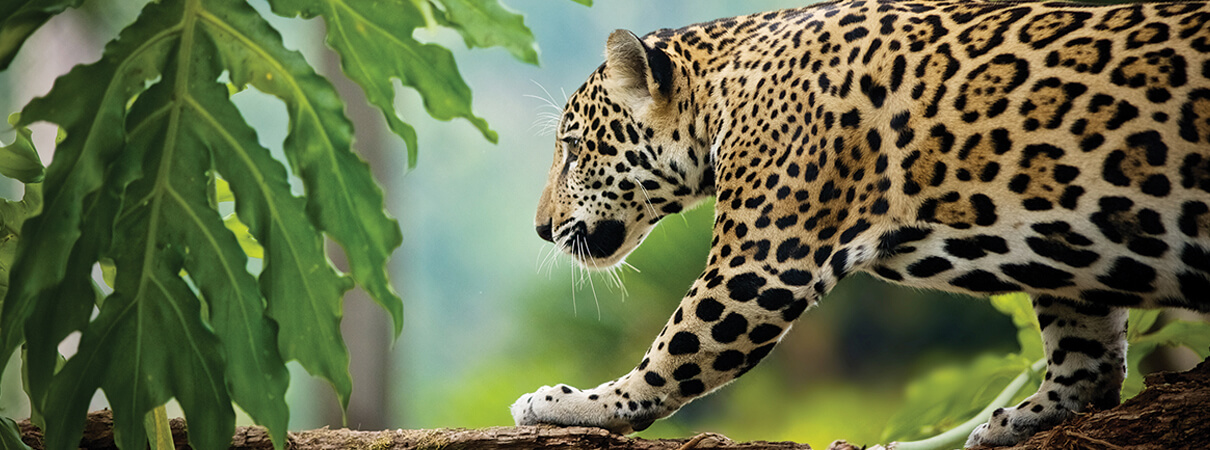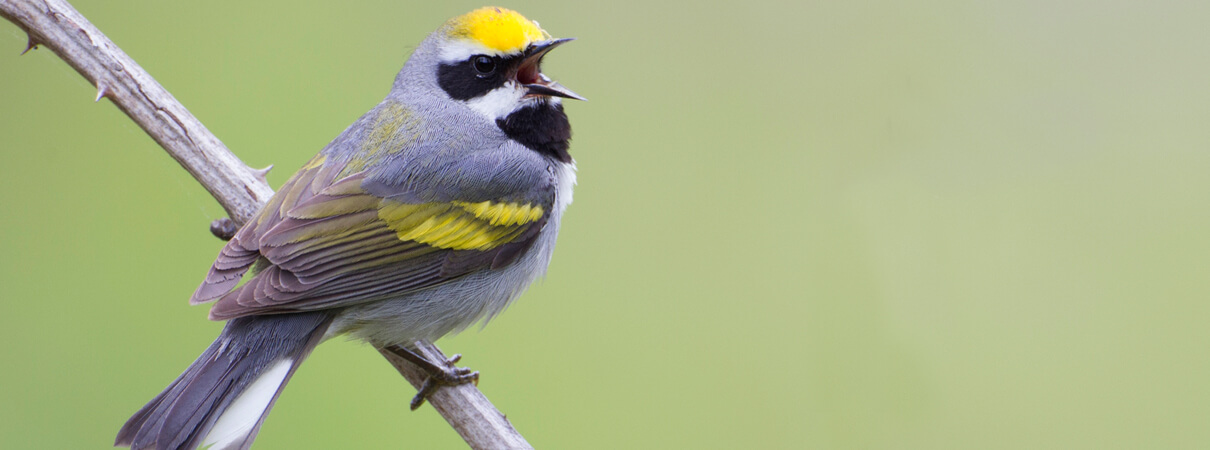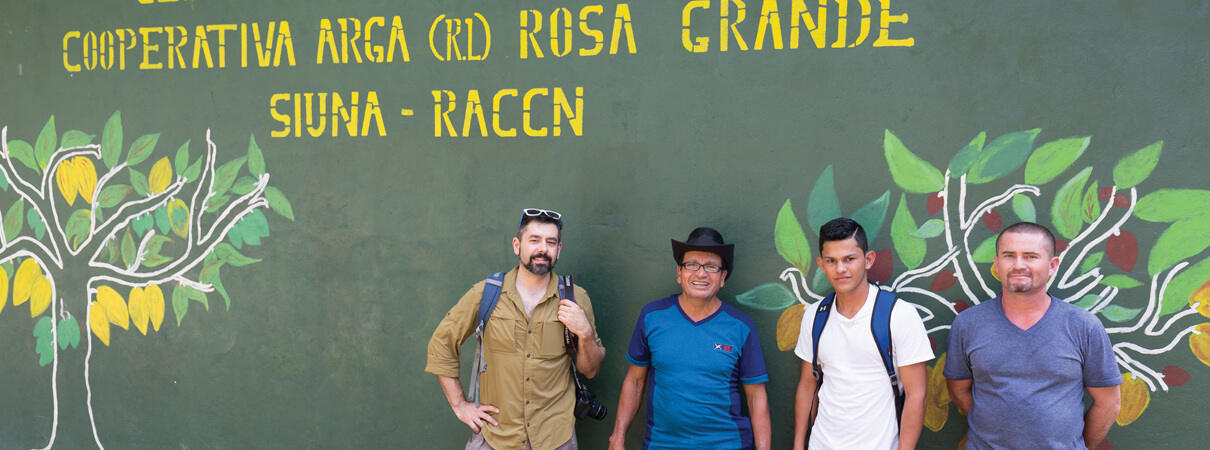A Quest to Save Wood Thrush (and Jaguars) in Nicaragua's Largest Remaining Forest
Every year, millions of Wood Thrush take to the skies and trade one chain of gentle mountains for another. They travel along the rolling ridge of the Appalachians, cross the Gulf of Mexico, and after brief sojourns to rest and refuel, alight in the humid forests of Central America. For many, Nicaragua is their final stop. They settle in for the winter.

Wood Thrush in winter by Chris Jimenez Nature Photo
Scientists have found that more than half of all Wood Thrush breeding populations depend on this part of Central America for food and shelter during the nonbreeding part of their life-cycle. As conservationists learn more about the impact of deforestation on population declines, they are increasingly focusing their efforts on specific regions where the loss of habitat is particularly acute. The thickly forested swath of Nicaragua known as the Bosawas Biosphere Reserve is one such place.
Designated a UNESCO site in the 1990s, the Bosawas is a natural marvel, and one of the largest remaining forests in Central America. Picture hundreds of species of butterflies and orchids, few roads, and wide rivers that snake through the dense vegetation. Its tropical forests provide critical stopover and wintering habitat for hundreds of species of migratory songbirds, including Golden-winged Warbler and Bay-breasted Warbler.
The Bosawas alone contains roughly 3 percent of the planet's biodiversity. It is the second-largest stronghold in Central America for jaguars — whose historic range once stretched from southern Argentina to the southwestern United States — and is an essential key in maintaining the great cats throughout their current, more-limited range. The reserve is also one of the last places in Central America where rare species such as the giant anteater and Harpy Eagle still survive.

But there are half a million people who call the Bosawas home, too. Political changes and poverty have shaped human migration in the region over the past two decades, and the influx of people has taken a severe toll on the land.
Along the edges of the reserve the Bosawas is losing forest at an alarming rate as farmers clear out trees, sell timber, and then graze cattle or grow basic crops such as maize and beans. Between 2006 and 2015, the rate of forest loss was between 6 and 11 percent across different areas of the Bosawas, with the highest rates within the buffer zone of Saslaya National Park.
Forests in Danger
This loss of habitat is bad news for the animals that depend on these forests for shelter and food. For more than a decade, the Wildlife Conservation Society (WCS) has been working with indigenous leaders in the core of the reserve to protect habitat for jaguars. Now, a new collaboration between American Bird Conservancy and WCS is taking that work a step further and conserving habitat for migratory birds, too.
It's a complex problem that conservationists are trying to address, and the solution is a mosaic. Over the next two years, conservationists from both organizations will encourage farmers to adopt silvipasture techniques that keep trees in place where crops grow; raise the profile of bird-friendly crops such as cacao, so that farmers are inclined to grow them; and step up patrolling of the borders of Saslaya National Park, Nicaragua's oldest and largest national park, to prevent further deforestation around the park's edges.

Jaguar by Enrique Aguirre/Shutterstock
The project marks an important point of convergence in conservation in this part of Central America, says Andrew Rothman, Director of ABC's Migratory Bird Program, who is overseeing the project.
“You have a key wintering area for species like Wood Thrush and Golden-winged Warbler in places like Saslaya National Park. You also have what appears to be a really important stopover site for lots of other migrants that travel further south, like Bay-breasted Warbler and Scarlet Tanager. And luckily you still have jaguars,” he says. “They all need the same thing. They need these large protected areas to stay intact. Our task is to work creatively to make that happen.”
A Promising Partnership
The story of this project begins, fittingly, at the El Jaguar Reserve. As the warbler flies, El Jaguar is about 60 miles southeast of Saslaya National Park, the mountainous gem of the Bosawas. Liliana Chavarria and Georges Duriaux, ABC partners and the reserve's owners, who run a shade coffee farm and ecotourism reserve for migratory birds, have also been conducting bird surveys in Saslaya. They knew the area was important for local species like Great Curassow, and they confirmed the presence of the rare Rufous-vented Ground-Cuckoo. But what about migratory birds?
Surveys revealed that migratory birds were indeed stopping over in the park or wintering there. Additional research later confirmed that collectively this region is of particular importance to Wood Thrush, with Saslaya potentially being a key stopover site. The problem was that Saslaya had become vulnerable to deforestation, with little enforcement of its unmarked borders.
During workshops that targeted expanded conservation in areas vital to Golden-winged Warbler, ABC's Rothman saw an opportunity. He began talking to scientists from WCS who had been collaborating with indigenous communities in the Bosawas region for years, and who were also working in Saslaya. Although these conservationists were focused primarily on jaguar conservation, WCS had cultivated extensive knowledge about the landscape and the communities, and with their encouragement a number of communities had agreed to manage their land differently. A promising partnership seemed possible.

Golden-winged Warbler by Michael Stubblefield
The fact that WCS had been working at a landscape level was particularly appealing to Rothman. In late 2016, ABC rolled out a new approach to bird conservation called BirdScapes. To protect birds across their full life-cycles means conserving habitat on a large scale — at the landscape level — at key breeding, wintering, and stopover sites. This immense forested area was included as one of the new BirdScapes. It seemed clear: The time was right to align ongoing jaguar conservation with bird conservation and slow further habitat loss in such an important area.
Since 1970, Wood Thrush and Golden-winged Warbler populations have declined by roughly 60 percent. Habitat loss on the wintering grounds is thought to be a key factor. Meanwhile, jaguars are desperate for vast acreage where they can roam freely. By joining forces, the project's organizers say, conservationists can push back against deforestation on a significant scale.
“The overwintering bird habitat is year-round jaguar habitat,” says John Polisar, Coordinator of the Jaguar Conservation Program for WCS. “Jaguars, in general, need large spaces. They need freedom from persecution, and they need an adequate prey base. And the birds need large pieces of intact forest. So this is basically a forest-preservation project for birds and jaguars.”
“Of course birds are more adaptable because they can fly away if need be,” Rothman adds. “But eventually there are fewer and fewer places to land. If we didn't have these large areas still available, over time, migrating birds would face the same situation as jaguars.”
Creating a Green Barrier
Situated on the southwestern edge of the project area, Saslaya National Park's buffer zone stretches roughly 40 miles into the core area of the Bosawas Biosphere Reserve. This represents a potentially vital corridor of forested habitat for birds and jaguars. Protecting the park's borders and persuading farmers in the buffer zone to grow bird-friendly crops such as cacao will create a green barrier to protect the park and create a vital link to the Bosawas reserve.

Cacao pod and seeds by John Hannan
Cacao is key. This small tree, which bears football-shaped pods that produce the seeds from which chocolate is made, grows best beneath the forest canopy. It can thrive alongside other lucrative crops such as cinnamon or allspice.
“Cacao doubles farmers' incomes,” says John Hannan, a contractor on the project who has worked in Central America for decades. “They move from a dollar a day per household to six dollars. And integrating other products that are native and work well in a forest canopy — like black pepper, cardamom, cinnamon — now you have a farm that is making much more money. Most importantly, you're appealing to every farmer, because it's not just about protecting the birds and butterflies, it's about putting more food on the table for their kids.”
Even so, growing cacao in this part of Nicaragua isn't a given, and part of the challenge of this new project will be to improve the quality of cacao production in the region, Rothman says. For many growers, “It's teetering right on the edge of, ‘Is it worth it for me to do cacao? Or should I plant something else?' ”
“If we're able to expand cacao production in areas that were previously turned into annual crops,” he continues, “the cacao itself will help with the restoration of those areas. It will draw in birds, helping with seed dispersal and providing cover. And in tropical ecosystems especially, forests can grow back very fast.”
Hannan agrees. The land has suffered, he says, but it's not lost. “If you have the birds dispersing seed, if you aren't mowing it down for cattle grazing or basic grains, the land will come right back,” he says.

Partners at the community of Rosa Grande, in the buffer zone of Saslaya National Park. Left to right: Andrew Rothman, ABC; Marcial Herrera Lopez, President of the Rosa Grande Co-op; and Joseph Luis Rojas and Jose Soza, student associates with the University of the Autonomous Regions of the Nicaraguan Caribbean Coast. Photo by John Hannan, 2017
If all goes as planned, this project will maintain and even increase the amount of quality habitat available for migratory songbirds and jaguars in an area long overlooked by many conservationists. It will improve prospects for people living in one of the most economically underserved areas in all of Central America. And it will mean a significant chunk of Central America's largest remaining patch of contiguous forest will be better protected.
“We want to create healthy, sustainable livelihoods for farmers and wildlife,” Rothman says. “That's really what this is about: sustaining life.”
This article first appeared in the spring 2018 edition of Bird Conservation magazine.
 |
Libby Sander is ABC's Senior Writer and Editor. |


















































